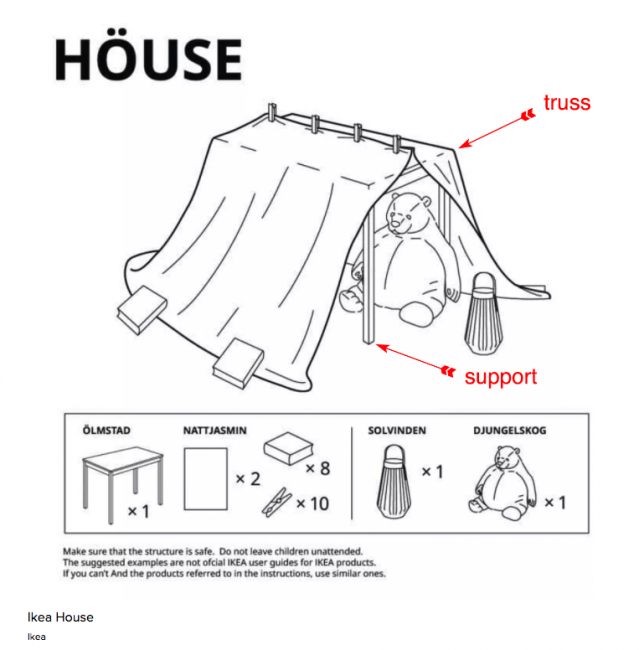Written by Nicholas Ogle
May 29, 2020
Family time should be treasured, but sometimes it can be good to have a space to call your own. A well-designed fort can be the perfect at-home getaway.
Fort building, while a time-honored tradition, is usually improvised. You can take your fort to the next level by considering some basic principles of physics and using the engineering design process.
Physics is the foundation of understanding how everything works in the physical world.
“Most people hear the word physics and they run for cover,” said Yesim Darici, a Girl Scout alumna who is the first female physics faculty member in Florida and the director of FIU's Center for Women’s and Gender Studies. “You are surrounded by physics all the time, and whether you realize it or not, you use physics every day.”

Darici was a Girl Scout in her native Turkey sometime between 1962 to 1966. This photo of her was teken when she was 9 or 10 years old.
MATERIALS
Whether you’re building a skyscraper or a living room pillow fort, there are a few aspects of physics and engineering design to keep in mind:
Design Requirements
The primary consideration of any building plan is how the force of gravity will act on the structure. Parts that run upright from the ground and hold everything up are considered supports. Any parts of the design that level and transfer the load to supports are trusses.
Considerations
Pay attention to the angles that are formed between these parts. Trigonometry, or the study of the relationship between the angles and lengths of the sides of a triangle, is one of the core principals of both physics and architecture. Through trial and error, try to determine if some angles make your structure stronger than others.
Selection
Weight is an important factor when choosing materials. Heavy or solid objects such as couch cushions or sticks may make better supports, while lighter materials such as blankets or sheets may be better suited as a roof. Other possibilities include suspending parts from the ceiling or using sturdy structures like chairs or couches to lighten the load.

Image modified from Ikea’s comfy homemade fort guide for context.
ENGINEERING AND DESIGN STEPS
Planning makes building the perfectly engineered fort easier. It is important to remember that what works for one person may not for another – ultimately only the engineer and the users of the fort can truly determine its success.
- Needs and Constraints: What is the goal? Should the fort represent a specific structure? Does it need to fit within a certain space? How many people will need to fit inside? Is the plan to decorate afterward and if so, what materials are best? Are there other goals that will make the fort unique, such as using recyclable or reused materials?
- Research: Find examples of different types of forts. What building materials have others used successfully? Are there any interesting additions that would be useful to incorporate into the design? Looking for some simple blanket fort ideas to get the creative juices flowing? Ikea has some fun examples along with some sample schematics.
- Imagine Solutions: Make a list of the available materials and include details such as weight or size. Draw a model that will show the form and features of the fort in a simplified way, helping visualize the final design. This is the time to be creative and think outside of the box. Even air from a fan can work as support for lighter materials.
- Selection and Prototypes: This is where the idea becomes reality. Select your most promising design and build a prototype, or small version of your fort. Build a few supports, walls and ceilings using your model as a guide.
- Testing: The moment of truth. Does the design hold together? Does it meet the requirements of the original needs laid out in step one? As with all scientific endeavors, communicate with others and get feedback about what works and what needs improvement. If the prototype is a success, it is time to bring the entire structure to life.
- Redesign: No design is ever perfect the first time around. Take feedback from the testing stage to make improvements on the original design. Make revisions, draw new and improved plans and test new materials to make your fort the best it can be.
NOW WHAT
Enjoy your fort and the unique space engineered for you – by you. Inspire others to tap into their inner engineer by sharing the final fort design and your steps along the way. Be sure to tag @FIUCASE.
Remember, forts can be just the beginning of your building adventure.
“Being a Girl Scout is the best start to being a scientist or anything you want to be,” Darici said.
Examples of solutions created at FIU using the engineering and design process are a click away at FIU’s Applied Research Center. To learn more about how physics is used to explore everything from outer space to the environment in South Florida, visit the FIU College of Arts, Sciences & Education’s Department of Physics.
The challenge to create something new is enthusiastically accepted by artists and scientists alike. Whether repurposed, recycled or reimagined – there are many ways to make something unique to solve a problem or enhance the world. Follow FIU@Home for more ways to create something new.